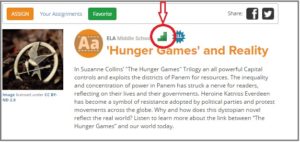Last Updated on March 7, 2018
A common question we hear from teachers using Listenwise is how to measure the reading level of an audio story. While it would be easy to choose podcasts based on reading level, listening is a different skill from reading. The two are closely related, however, choosing a story based on a reading level would miss opportunities that listening provides. Research shows students can listen and understand content that is 2-3 grade levels above their reading level.
That’s why we created Language Challenge Levels.
Identifying which audio resources students will best understand is a difficult task. There is not a wealth of information on matching students to appropriate audio podcasts, or widely accepted leveling frameworks, such as Lexile levels, available to support teachers. This is why we added a Language Challenge Level on every story in our lesson collection (not included in current events). We want to help teachers select appropriate stories for their students.
Choosing Audio Stories
Our Language Challenge levels can help teachers find the right stories for their students. The levels do not relate to the content of the audio, but to the complexity of the vocabulary, sentence length and structure, and language in the story. Our levels of language challenge are not directly related to reading levels, but that is taken into consideration. In choosing audio stories, teachers should take into account the factors of language complexity, curriculum-aligned content, appropriate subject matter and student interest. These factors combined will help you choose the right audio stories for the right students.
Listenwise Language Challenge Levels
 Low: These stories are easier to understand and are a good starting point for elementary students or English learners. For example, Protests in Baltimore.
Low: These stories are easier to understand and are a good starting point for elementary students or English learners. For example, Protests in Baltimore.
![]() Medium: These stories have an average language challenge for middle and high school students, and can be scaffolded for English Learners. For example, Themes of Belonging: Sandra Cisneros.
Medium: These stories have an average language challenge for middle and high school students, and can be scaffolded for English Learners. For example, Themes of Belonging: Sandra Cisneros.
![]() High: These stories have challenging vocabulary and language and students may need to have some background knowledge to understand the story. For example, Pollution Thought to Melt Glaciers.
High: These stories have challenging vocabulary and language and students may need to have some background knowledge to understand the story. For example, Pollution Thought to Melt Glaciers.
Students at each grade are expected to read and understand increasingly complex texts to meet demanding state standards. This is challenging for teachers when there are many reading levels in a classroom. Listening is one way to achieve those goals regardless of reading level, since research shows that students who understand while listening also understand while reading.
Take a look at the Language Challenge levels on our lessons and start listening with your students!


Hello,
My students of Technology Courses at College are of heterogeneous levels of fluency. Would themes related to Information Technology be available?